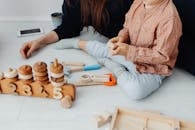DIY Dry Erase Cloths Using Old Fabric (Budget Friendly)

“No one is perfect, that’s why we have erasers”-Anonymous
At Southern Schoolhouse, we love finding ways to repurpose old materials, like recycling flannel to create dry erase board erasers. This eco friendly, money saving craft is loved by the kids and makes your classroom feel homey.
Exploring the Heart of the Nation: A D.C. Field Trip Adventure!

Our nation’s capital is a wonderful place to take a field trip. This was my son’s first overnight trip with our school and my husband and I both had the privilege of chaperoning.
Tips for National Boards Prior to Submission

Trying for National Boards is challenging. Here are some of the steps I took prior to submission to make the process smoother.
Make Your Own Letter Formation Sand Tray and Letters

Prior to owning my sand tray. I used a plastic pencil box filled with a little salt or sand. I filled the entire bottom of the pencil box with about a half an inch of sand. These boxes were perfect due to the built-in lid.
How to Teach Letter Identification and Formation

Teaching letter identification and formation is a commonly taught skill in early grades and special education. All littles, including those with motor and attentional difficulties will benefit from a multi-sensory approach to learning this skill.
Organizational Systems in Small Group Learning

In all aspects of teaching, it is important to be organized and ready for each transition. When I moved from the regular classroom to the EC resource position, I found that my organization had to look different. In this article, I am going to share how I organize my materials for the many transitions I have throughout my day. I know not every technique works for everyone and even after six years, it is still a work in progress.
Dynamic Collaboration: Team Teaching Through Rotating Stations

Joy and I are the only two resource teachers at our school. It has taken us a few years, as our EC (Exceptional Children) population has grown, to figure out ways to fit everyone into a schedule. Covering service time, as well as building in time for our transitions, is always a challenge.
Sensory Tools: Unlocking the Power of Play and Focus

Over the years, I have definitely noticed an increase in sensory needs among all children and even adults. I know there are a variety of reasons for this increase, but for this article, we want to share some of the sensory tools that have been used in our classrooms and have helped with engagement and regulation.
Sensory Seating: Creating Comfort and Focus for Every Learner

Sensory Seating increases engagement. It is an important set of tools that can help to improve the success of your learning environment. We love sensory seating. It can be strategically placed ahead of time for those students that you know need extra sensory input and wiggle time.
Mastering the Skill of Theme: Guiding Students to Deeper Understanding

I don’t ever remember a time that I couldn’t read. I know that sounds like a stretch but I really don’t remember learning how to read – I could just read and I loved it. I was the shy girl that rode the bus to school for an hour and a half and I had my nose in a book all the way to school and all the way home. I am sure I had a book stuck in my desk at school that I would pull out when I finished my work to fill up my free time. My elementary school librarian would see me coming and say, “Another one already Beth?” So reading came easy to me to start with and I have always enjoyed it. I love reading mysteries, romance novels, suspenseful thrillers, biographies, autobiographies, and books on topics I am interested in at any given moment. As I reflect on my teaching career, I can think of SOME students who had a love for reading that matched my own. Unfortunately, I am sure you have found, as I have, that the majority of students struggle with reading in some way or they just do not find the joy in it. Reading is a chore for them and if given a choice they would not pick up a book. It breaks my book-loving heart!
Being Your Child’s Best Advocate

A new school year is beginning which usually means a new teacher, new classroom routines, new expectations and sometimes new stressors and a little anxiety. What can you do to be your child’s best advocate and alleviate some of the stress that comes with a new school year? I believe it starts with relationships. Your child’s teacher will begin building a relationship with each student on the first day of school, but I believe it is important for you as a parent to begin to build that relationship with the teacher as well.
